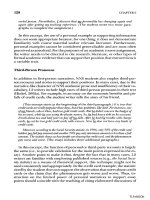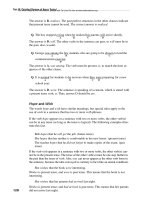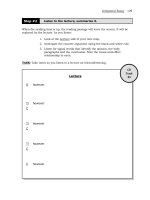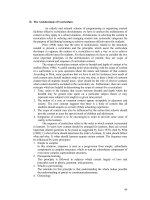Express yourself part 15 doc
Bạn đang xem bản rút gọn của tài liệu. Xem và tải ngay bản đầy đủ của tài liệu tại đây (84.45 KB, 10 trang )
The undiscovere’d country, from whose bourn
No traveller returns, puzzles the will,
And makes us rather bear those ills we have
Than fly to others that we know not of?
Thus conscience does make cowards of us all,
And thus the native hue or resolution
Is sicklied o’er with the pale cast of thought,
And entrerprises of great pitch and moment
With this regard their currents turn awry
And lose the name of action.
1. Find the line or lines which tell us that Hamlet is thinking about being dead.
2. Find the line or lines which suggest that he views dying as the easy way out of a problem.
3. Find the line which suggests that Hamlet is worried about what may come after death.
4. How does Hamlet characterize death?
5. How does Hamlet regard his conscience?
6. What do the lines, “And thus the native hue of resolution/Is sicklied o’er with the pale cast of thought”
mean?
WRITING ABOUT DRAMA EXPRESS YOURSELF
129
7. Explain the metaphor for death that Hamlet uses in the opening lines.
8. What is the resolution to the opening question?
How is reading this soliloquy different from reading it as if it were a poem? Without the benefit of the
plot and setting it could be a poem. But it does have a setting, a plot sequence, and characterization to breathe
life into it. Once you know that Hamlet is considering suicide because he is so upset about his situation, and
that he is considering murdering his uncle to avenge his father’s death, you read these lines about death and
dying with much more power and intensity. Indeed, the playwright gives us a far more powerful presenta-
tion about the conflict between conscience and behavior because these lines are spoken by a man, not merely
written.
Thus, when we listen to this man feeling the need to kill himself because life has been so brutal to him,
we hear his pain. When he talks of “sleep” as a metaphor for death, and he considers “dreams” as a logical
consequence of sleep therefore even in death there may be something beyond peace, we hear his fear. And
when he tells us that “conscience” makes us all cowards, afraid to die because we know how guilty we have
been in life and therefore uncertain of the “dreams” that will follow us to eternity, we become partners with
him.
We come to understand that “the native hue of resolution,” or the resolve to kill oneself or even kill
another, is “sicklied o’er” with “thought” and after considering it seriously, Hamlet has lost “the name of
action.”
Notice that in answering the questions presented above, an analysis of the soliloquy has started. Notice,
too, that in answering the questions direct quotes from the lines have been given. In responding to drama,
using the words of the characters is extremely important. They are the keys to supporting our interpretations.
The second important difference between plays and other forms of literature is the compressed nature
of the action. Often, plays take place in a matter of days in the lives of its characters. Rarely do they take place
over the course of years. They frequently open in the middle of things, giving us background as we go along,
and then take us with them to the end of whatever crisis is occurring.
We are invited in to witness action in the daily lives of these people, often just like ourselves. We listen
to their conversations and soliloquies, and observe the consequences of their words and actions. Ultimately,
it is our reaction to their words and the reactions of the characters on stage, which will guide our interpre-
tation of the play. In the case of Hamlet, the young prince who has returned home from school to find a mur-
dered father and a remarried mother (to his father’s brother no less) we read much between the lines. We
read the soliloquy above and understand why he would even consider suicide; his pain is almost unbearable.
Now consider this essay question based on the soliloquy above:
EXPRESS YOURSELF WRITING ABOUT DRAMA
130
In his “To be, or not to be” speech, the young Prince Hamlet carefully considers the bound-
aries between life and death. Using specific lines from the speech, show how Hamlet’s thinking
evolves from the opening question to its concluding answer.
Thus, when responding to any piece of literature, it is careful reading, and attention to textual detail,
that will make you a better writer about literature. Stories, poems, and plays are not inkblots, subject to ran-
dom interpretation. They are carefully crafted works of art, which provide all the necessary details to sup-
port valid opinion. On the next two pages is a rubric that might be used to evaluate a literary essay.
***
If you look carefully at the rubric that was adapted from a New York State Comprehensive English
Regents Examination Rubric used to score a literary essay, you will notice that the most important qualities
of an essay are meaning, development, and organization. Language use and following the conventions of stan-
dard written English are important but they are at the bottom of the rubric.
The reference to meaning in the rubric is whether or not you have grasped the implied or inferential
complexities of the story and its characters. Did you understand the subtleties of characterization? Did you
notice how the author created tone and mood? For instance, with the Hamlet soliloquy, were you able to see
that his despair is heightened for us because he seems obsessed with death and dying? He is not just sad. He
is despondent and morose.
The reference to development in the rubric concerns whether or not you have developed your inter-
pretation(s) with specific details from the text to prove that your interpretation is accurate and not just an
inkblot reaction. Did you use specific quotes? Were you able to identify literary devices such as irony or satire
and show how they contributed to your interpretation? Did you recognize figurative language such as simi-
les and metaphors, and could you use them to reinforce your opinion? Can you connect Hamlet’s reference
to dreaming and conscience?
The reference to organization in the rubric is specific to the organization of your essay. Does it have a
good introduction with a clear thesis statement (focus)? Do you have body paragraphs that are logically pre-
sented with good transitions? Does your conclusion restate your thesis and secure your interpretation as valid?
The reference to language use in the rubric means your language not the author’s. Is your vocabulary
varied? Sad is not the only word for Hamlet. Are you repetitious? Are your sentences varied or are they all
simple sentences? Notice that there isn’t much difference between the 5 and 4 paper in this category. But look
at 3 and 2. The reference to ordinary, imprecise, vague, and even inappropriate language are traps that are easy
to fall into. Even when you are confident that you understand a short story or poem to its very core, you can
falter when trying to express yourself. Start trying to build your vocabulary so that you are have a repertoire
of words from which to choose.
Finally, the reference to conventions in the rubric means exactly what it says: spelling, punctuation, para-
graphing, grammar, and usage. A thoughtful, insightful interpretation of a literary piece can be doomed to
a low grade if it is filled with mechanical or homonym (your/you’re) errors. Paragraphs must be as organized
as entire papers are organized, with topic sentences and supporting details. Be sure to carefully proofread
and edit your final copy.
A last word about proofreading and editing. By the time you reach your junior and senior year in high
school you will be writing in timed test situations, many of which will have enormous consequences—high
school graduation being just one. During those tests you will not have the benefit of peer or teacher review
WRITING ABOUT DRAMA EXPRESS YOURSELF
131
EXPRESS YOURSELF WRITING ABOUT DRAMA
132
RUBRIC FOR LITERATURE ESSAYS
Quality 54321
The response: The response: The response: The response: The response:
Meaning: • Accurately identifies lit- • Accurately identifies • Limited understanding • Brief, sketchy dis- • Demonstrates poor to no
The extent to erary devices and de- some of the details of the meaning and cussion of the understanding of the
which the re- tails which convey the that contribute to the purpose of the piece. meaning. message and purpose.
sponse identifies author’s meaning and meaning and purpose • Relies on literal infor- • Poor understanding of
the author’s purpose. of the piece. mation. the inferential meaning.
theme and pur- • Interprets the com- • Limited interpretation. • Provides little insight to
pose for writing plexity of thought the implied meaning.
and responds to in the literature.
the tone and
mood of the piece.
Development: • Makes effective use of • Supports discussion • Supports discussion • Mentions some ideas • Conveys vague or un-
The extent to generalization, specific with appropriate gen- with specific refer- and information from supported ideas, or
which the dis- references and relevant eralizations, specific ences to the piece, the piece, with some presents random list of
cussion is elab- quotations from the references, and rel- with main ideas usually attempt to distinguish details.
orated through piece to support evant quotations distinguished from main topics from • Includes inaccurate and/or
specific refer- discussion. from the text. supporting details. details. irrelevant use of refer-
ences to the • Develops ideas fully, • Develops ideas fully, • Develops ideas simply, • Includes limited range ences from the piece.
author’s choice using a wide range of using a wide range of using a limited range of details that may be
of genre, detail, relevant textual relevant textual of textual support. irrelevant or inaccurate.
figurative lan- support. support.
guage, and other
literary devices.
Organization: • Establishes a clear, • Establishes a clear and • Establishes an appro- • Establishes some • Lacks a focus for the
The extent to original, relevant focus relevant focus for the priate focus for the direction for the response and shows
which the re- for the response. response. essay. response, but organi- little or no evidence of
sponse exhibits • Exhibits a logical and • Exhibits a logical and • Exhibits a discernible zation is tentative. organization.
WRITING ABOUT DRAMA EXPRESS YOURSELF
133
RUBRIC FOR LITERATURE ESSAYS (continued)
Quality 54321
The response: The response: The response: The response: The response:
paragraph devel- coherent organization- coherent organization- structure.
opment, tran- al structure through al structure through the
sitions, and effective use of such use of such devices
logical progres- devices as introduction, as an introduction,
sion of ideas. conclusion, and transi- conclusion, and
sitions that contribute transitions.
to the cohesion of the
whole.
Language Use: • Conveys ideas and in- • Conveys ideas and in- • Uses ordinary language • Relies on ordinary, • Includes some vague,
The extent to formation in original formation in original or language from the often imprecise lan- inappropriate, and/or
which the re- and precise language and precise language. piece to convey ideas guage to convey ideas incorrect language.
sponse exhibits with a noticeable • Shows consistent use and information. and information. • Relies on run-ons or
effective use of sense of voice. of sentences that are • Relies on sentences • Relies on sentences sentence fragments.
words, sentence • Makes effective use of varied in length and that are unvaried in that lack variety in
structure, and sen- sentence structure and structure. length and structure. structure and length
tence variety to length to convey ideas. and may be con-
convey ideas. structed incorrectly.
Conventions: • Exhibits correct spell- • Exhibits generally cor- • Exhibits minor errors in • Exhibits errors in spell- • Exhibits error in spelling,
The extent to ing, punctuation, para- rect spelling, punctua- spelling, punctuation, ing, punctuation, para- punctuation, paragraph-
which the re- graphing, grammar, tion, paragraphing, paragraphing, graphing, grammar, or ing, grammar, or usage
sponse exhibits and usage. grammar, and usage. grammar, or usage usage that may inter- that often interfere with
conventional spell- • Error-free. that do not interfere fere with communi- communication.
ing, punctuation, with communication. cation.
paragraphing,
grammar, and
usage.
to help you proofread or edit before you submit a final copy. But if you take advantage of the opportunity to
peer review the work you do every day, to become alert about how you write and the mistakes you commonly
make, as well as the suggestions of others about how to improve your work, you will become more astute at
proofing your own test work.
There are several peer review sheets at the end of this book which you should try to use routinely before
you hand in a written assignment. You will notice that they all refer to things like “thesis statement,” “para-
graph development,”“word choice,”and even “conventions.”You can modify them to match the requirements
of a particular assignment. For example, if the assignment requires that you write about Hamlet’s soliloquy
and select at least three references to death and dying, then you can add that criteria to the peer review sheet
to make sure your reader picks up whether or not you have addressed this in your finished piece.
Finally, there is no magic bullet to help you express yourself. Reading insightfully, acquiring good vocab-
ulary, recognizing logic, and preparing well-organized papers are all skills that have to be worked at.
EXPRESS YOURSELF WRITING ABOUT DRAMA
134
APPENDIX
TIPS FOR
PEER
REVIEW
Real writing takes shape during revision. You’ll want to use the peer review forms found here to check and
revise your work to make it the best it can be.
Peer Review 1
1. Does the first paragraph get your interest? What details, information, quotation accomplishes this?
What, if anything, is still needed?
2. At the end of the first paragraph, do you know what the thesis is? Express the thesis in the author’s
words or your own.
3. As the author tells the story, are the details vivid and interesting? Point out several good ones.
4. Is there a logical time sequence? What transition words or phrases capture the sense of time?
135
A
APPENDIX A EXPRESS YOURSELF
5. Are more details needed anywhere? If so, explain.
6. Are there any good comparisons (similes and metaphors)? List them below.
7. Are you satisfied with the conclusion? Does it restate the opening? If you think it could be better,
please write it out.
8. Do you see any serious grammatical errors? Circle the places where you think there is an error. Give
suggestions for better wording.
Peer Review 2
1. Does the introduction effectively identify the issue, engage the reader’s interest, provide needed back-
ground, and provide the writer’s thesis? How might the writer improve the introduction? Suggest a
quotation, statistic, or anecdote.
2. If the introduction predicts the organization of the paper, do the body paragraphs follow the thesis
statement? Do you ever have trouble seeing the purpose or function of the paragraphs? Can you cir-
cle the transition words or phrases?
3. Identify places where the prose is confusing or unclear. In particular, look at abrupt transitions, gaps
in arguments, tangled sentences, or other places where you get lost.
EXPRESS YOURSELF APPENDIX A
136
4. Is each paragraph well-developed? Is there a good topic sentence with at least three supporting sen-
tences? Is there a clear transition from paragraph to paragraph?
5. Does the conclusion restate the introduction?
6. What are the main strengths of the paper? Underline one or more important phrases.
7. What are at least two changes the writer should consider making?
Peer Review 3
1. What is the thesis statement? Copy it below.
2. How many paragraphs make up this essay?
3. Is the first paragraph an effective introduction? What introduction strategy does the writer use—
that is, quotation, statistic, or anecdote?
4. Is each body paragraph adequately developed? What evidence is used to support the thesis? Is the
evidence compelling? Select one or two pieces of supporting information that you think are very good.
APPENDIX A EXPRESS YOURSELF
137
5. Which parts of the essay do you find most effective? Cite a specific sentence, paragraph, or example
to support your opinion.
6. What did you learn from this essay?
7. Make one suggestion for improvement.
8. Read over for the conventions of standard written English; circle errors, but do not make corrections.
That is the writer’s job.
Revision Guidelines for Self Evaluation
Before submitting your work, check the following:
1. Can you underline your thesis statement?
2. Does each paragraph begin with a recognizable topic sentence that introduces a major point to be
developed in the paragraph?
3. Can you identify transitional words or phrases in each paragraph?
EXPRESS YOURSELF APPENDIX A
138









